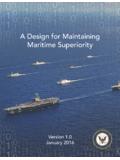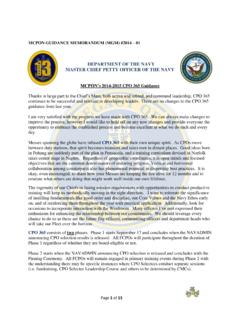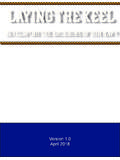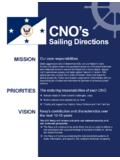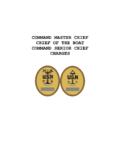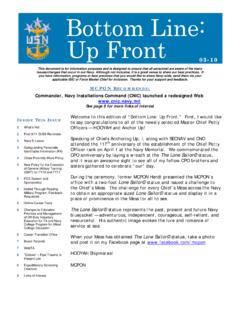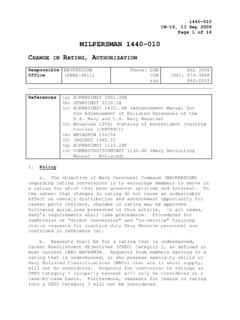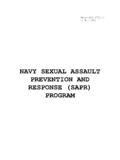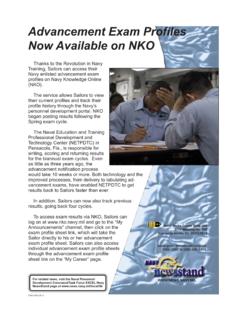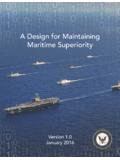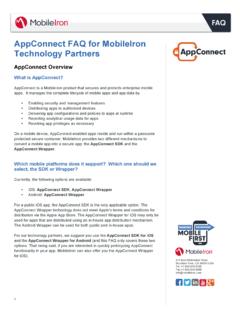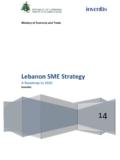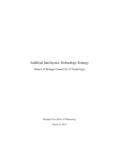Transcription of The Navy Unmanned Undersea Vehicle (UUV) …
1 The navy Unmanned Undersea Vehicle (UUV) master Plan November 9, 2004. Approved for Public Release; Distribution Unlimited. UUV master Plan UUV master Plan Abstract The Unmanned Undersea Vehicle (UUV) master Plan Update, chartered in December 2003 by the Deputy Assistant Secretary of the navy and OPNAV N77 (Submarine Warfare Division), expands on the missions and technologies recommended in the navy UUV master Plan of April 2000. Using Sea Power 21 for guidance, nine Sub-Pillar capabilities were identified and prioritized: 1. Intelligence, Surveillance, and Reconnaissance 2. Mine Countermeasures 3. Anti-Submarine Warfare 4. Inspection / Identification 5. Oceanography 6. Communication / Navigation Network Node 7. Payload Delivery 8. Information Operations 9. Time Critical Strike To realize these capabilities, a number of programmatic recommendations were made: 1. Develop four UUV classes: Man Portable (<100 lbs), Light Weight (~500. lbs), Heavy Weight (~3000 lbs), and Large (~20,000 lbs).
2 2. Develop standards and implement modularity 3. Establish a balanced UUV technology program 4. Increase experimentation in UUV technology 5. Coordinate with other Unmanned Vehicle programs 6. Field systems in the fleet UUV master Plan Concurrence and Approval Concurring: _____. William E. Landay III, RDML, USN. PEO(LMW). _____. Michael A. LeFever, RDML, USN. OPNAV N75B. _____. Raymond A. Spicer, RDML, USN. OPNAV N76B. _____. Roseanne M. Levitre, RDML, USN. OPNAV N6/N7 Director ISR/FORCEnet _____. Steven J. Tomaszeski, RADM, USN. OPNAV N61/Oceanographer of the navy Approved: _____. Joseph A. Walsh, RDML, USN. OPNAV N77. _____. Roger M. Smith DASN L&MW. UUV master Plan Table of Contents Table of i List of v List of Tables .. vii List of Acronyms and ix Executive Summary .. xv 1 The 1. navy 2. Sea Power 21 Impact .. 3. UUV 4. Linkage to Other UUV Plans and Studies .. 5. 2 Missions .. 7. Mission Generation Methodology .. 7. UUV master Plan Study Team .. 7. Year 2000 Field Surveys and Expert 7.
3 Update Study Workshops .. 7. Related 8. Study Team Analysis .. 9. Mission 9. Intelligence, Surveillance and Reconnaissance (ISR) .. 9. Mine Countermeasures (MCM).. 10. Anti-Submarine Warfare (ASW) .. 12. Inspection / Identification (ID) .. 13. Oceanography .. 13. Communications / Navigation Network Node (CN3) .. 14. Payload 14. Information Operations (IO) .. 14. Time Critical Strike (TCS).. 15. Barrier Patrol for Homeland Defense and Force 15. Sea Base Support .. 15. Mission Prioritization / Suitability for 16. 3 UUV Sub-Pillar 19. Intelligence, Surveillance and Reconnaissance (ISR) .. 20. Objective .. 20. Background .. 21. Concept of Operations .. 21. System 22. Technology and Engineering Issues .. 22. Mine Countermeasures (MCM).. 23. Objective .. 23. Background .. 24. Concept of Operations .. 24. i UUV master Plan System 26. Technology and Engineering Issues .. 28. Anti-Submarine Warfare (ASW) .. 30. Objective .. 31. Background .. 31. Concept of Operations .. 32. System 33.
4 Technology and Engineering Issues .. 34. Inspection / Identification .. 35. Objective .. 35. Concept of Operations .. 37. System 37. Technology and Engineering Issues .. 38. Oceanography .. 39. Objective .. 40. Background .. 40. Concept of Operations .. 40. System 41. Technology and Engineering Issues .. 41. Communication / Navigation, and Network Node (CN3) .. 42. Objective .. 42. Background .. 43. Concept of Operations .. 44. System 45. Technology and Engineering Issues .. 46. Payload 46. Objective .. 46. Background .. 47. Concept of Operations .. 47. System 48. Technology and Engineering Issues .. 48. Information Operations (IO) .. 48. Objective .. 48. Background .. 49. Concept of Operations .. 49. Technology and Engineering Issues .. 50. Time Critical 50. Objective .. 51. Background .. 51. Concept of Operations .. 52. System Concept .. 52. Technology and Engineering Issues .. 53. 4 UUV Technology and Engineering 55. Technology Area Risk Assessment .. 55. Autonomy .. 57. Energy.
5 58. ii UUV master Plan Sensors and Sensor Processing .. 58. Communications and Networking .. 59. Engagement / 59. Engineering 60. Energy Source Selection .. 60. Launch and Recovery .. 62. Shipboard Certification of UUV 63. Simulation and 63. UUV Interoperability and 63. FORCEnet 64. Implementation 65. 5 Recommendations and Conclusions .. 67. Meeting Mission Requirements with Four Classes of 67. Man Portable Vehicle 68. Light Weight Vehicle (LWV) Class .. 68. Heavy Weight Vehicle (HWV) Class .. 69. Large Vehicle Class .. 69. Commonality and Modularity of UUVs .. 70. Programmatic Recommendations .. 70. Develop Four UUV 70. Develop Standards and Implement Modularity .. 71. Maintain a Balanced UUV Technology 71. Increase Experimentation in UUV 72. Coordinate with Other Unmanned Vehicle Programs .. 72. Field Systems in the Fleet .. 72. Human Systems Integration (HSI).. 72. Technical Recommendations .. 72. Autonomy .. 73. Energy and 73. Sensors and Sensor Processing .. 74. Communications / Networking.
6 75. Engagement / 76. Conclusion .. 77. Appendix A : References .. 79. Appendix B : Year 2000 UUV master Plan Field Study Results .. 83. Appendix C : Year 2000 UUV master Plan Expert Panels .. 87. Appendix D : Year 2004 UUV master Plan Update Expert Panels .. 89. Appendix E : Year 2004 UUV master Plan Update 95. iii UUV master Plan List of Illustrations Figure ES-1. UUVs at War.. xv Figure ES-2. UUV master Plan xvii Figure ES-3. Sea Power 21 Sub-Pillar Groupings .. xx Figure ES-4. General Classes of UUV Sizes vs. Sub-Pillar .. xxiii Figure ES-5. UUV master Plan Program Roadmap .. xxiv Figure 1-1. UUV master Plan Vision .. 2. Figure 2-1. UUVMP Update Workshop Process 8. Figure 2-2. MIW Mission 10. Figure 2-3. Littoral Mine Threats .. 11. Figure 2-4. Task Force ASW Nomenclature .. 12. Figure 2-5. Merged UUV Mission Priorities .. 16. Figure 2-6. UUVMP Sub-Pillar Linkage .. 17. Figure 3-1. Year 2000 UUV master Plan Signature 19. Figure 3-2. UUV Sub-Pillars Mapped to Sea Power 21 Pillars.
7 20. Figure 3-3. ISR UUV 21. Figure 3-4. MCM 23. Figure 3-5. Counter Mining 24. Figure 3-6. Resultant Area Coverage Rate for Maneuvering, Multi-Sensor 26. Figure 3-7. UUV System Options for MCM 27. Figure 3-8. MIW Through-the-Sensor (TTS) Environmental Data Collection (EDC) .. 30. Figure 3-9. ASW Sub-Pillar Concept of Operation Hold at Risk .. 31. Figure 3-10. Inspection / Identification Sub-Pillar 36. Figure 3-11. Oceanography Sub-Pillar .. 39. Figure 3-12. Communication/Navigation Network Nodes (CN3) Sub-Pillar .. 43. Figure 3-13. Potential Non-Conventional CN3 Platforms: Glider or Solar 45. Figure 3-14. Payload Delivery 47. Figure 3-15. Information Operations 49. Figure 3-16. Time Critical Strike (TCS) 51. Figure 4-1. Technology Assessment Process for master Plan Update .. 55. Figure 4-2. Sub-Pillar Functional Analysis .. 56. Figure 4-3. Sub-Pillar Areas .. 56. Figure 4-4. TRL & Technology Importance Assessment 57. Figure 4-5. Technology Readiness Levels of Sub-Pillar Functions vs.
8 UUV Subsystems .. 57. Figure 4-6. UUV Energy Options versus Vehicle Size .. 61. Figure 4-7. Comparison of Large UUV Energy Option 62. Figure 4-8. FORCEnet in Action .. 64. Figure 5-1. UUV Classes .. 67. Figure 5-2. UUV Class vs. Mission .. 68. Figure 5-3. UUV master Plan Program 71. Figure 5-4. Technology Roadmap for 73. Figure 5-5. Technology Roadmap for Energy .. 74. Figure 5-6. Technology Roadmap for Sensors .. 75. Figure 5-7. Technology Roadmap for Communications/Networking .. 76. v UUV master Plan Figure 5-8. Technology Roadmap for Engagement Intervention .. 77. Picture E-1. UUVMP Update Workshop Process Flow .. 95. Picture E-2. UUV Mission 96. Picture E-3. UUVMP Update Workshop 2 Agenda .. 97. vi UUV master Plan List of Tables Table 3-1. ISR Notional Capability .. 22. Table 3-2. Mine Hunting COEs .. 25. Table 3-3. Notional Capabilities, Hold At Risk 34. Table 3-4. Inspection/Identification Capability 37. Table 3-5. Oceanography Notional 41. Table 3-6. Communication/Navigation Network Node (CN3) Notional Capabilities.
9 44. Table 3-7. Payload Delivery Notional 48. Table 3-8. Time Critical Strike (TCS) 52. vii UUV master Plan viii UUV master Plan List of Acronyms and Abbreviations 21 MRUUV 21-inch Mission Reconfigurable UUV. ACINT Acoustic Intelligence ACOMMS Acoustic Communications ACR Area Coverage Rate ADC Association of Diving Contractors International, Inc. ADCAP Advanced Capability ADS Advanced Deployable Systems AMPHIB Amphibious Warfare Ship AO FNC Autonomous Operations Future Naval Capability AoA Analysis of Alternatives AOA Amphibious Operating Area ARL Applied Research Laboratory ASDS Advanced Swimmer Delivery System ASN/RDA Assistant Secretary of the navy for Research, Development &. Acquisition ASW Anti-Submarine Warfare AT/FP Anti-Terrorism/Force Protection ATR Automatic Target Recognition ATV All-Terrain Vehicle BPAUV Battlespace Preparation Autonomous Undersea Vehicle BSP Battlespace Preparation C3 Command, Control, Communications C4 ISR Command, Control, Communications, Computers, Intelligence, Surveillance, and Reconnaissance CAC Computer-Aided Classification CAD Computer-Aided Detection CAI Computer-Aided Identification CAPTOR Encapsulated torpedo ASW mine (MK 60).
10 CBNRE Chemical, Biological, Nuclear, Radiological, and Explosives CN3 Communication/Navigation Network Nodes ix UUV master Plan CNA Communication/Navigation Aid CNO Chief of Naval Operations COA Carrier Operating Area COE Concept of Employment COMINT Communications Intelligence COMM Communications Con Contacts CONOPS Concept of Operations COTS Commercial-Off-the-Shelf CSG Carrier Strike Group CUP Common Undersea Picture DADS Deployable Autonomous Distributed System DCIN Detect, Classify, Identify, Neutralize DoD Department of Defense EDC Environmental Data Collection ELINT Electronics Intelligence EMATT Expendable Mobile ASW Training Target EOD Explosive Ordnance Disposal ESG Expeditionary Strike Group EXW Expeditionary Warfare FNC Future Naval Capability GCCS-M Global Command & Control System - Maritime GIG Global Information Grid GPS Global Positioning System GWOT Global War on Terrorism HAUV Hovering Autonomous Undersea Vehicle HLD Homeland Defense HSI Human Systems Integration HWV Heavy Weight Vehicle IAW In Accordance With ID Identify x UUV master Plan IEEE Institute for Electrical & Electronics Engineers IER Information Exchange Requirements IMINT Imagery Intelligence INFOSEC Information Security IO Information Operations IOC Initial Operational Capability IPB Intelligence Preparation of the Battlespace IPL Image Processing Library ISLAMM Improved Submarine Launched Mobile Mine ISR Intelligence.
